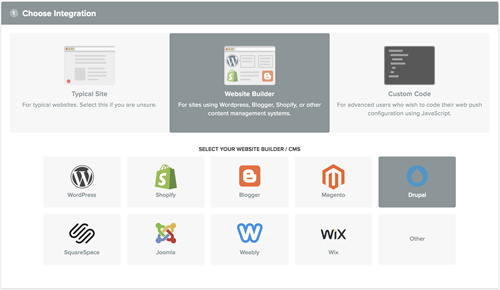Get your free consultation today!
Share with your Colleagues
Categories
ROI Calculator
Moonstone Interactive is the only San Francisco Bay Area web design firm and Internet Marketing expert that offers a free online ROI Calculator
Author: JJ Jenkins

With so many options available on the markets, picking the correct content management system can be challenging. A content management system (CMS) has to be sophisticated enough for whatever the need may be, yet comfortable enough to use so that a non-technical person can easily make changes or add content.
Drupal separates itself from CMS applications in that it's a platform that you can use to build a CMS application. WordPress and Joomla are great CMS applications built for mostly basic content such as pictures, videos, and blogs. Drupal is "an open-source platform," so it's a blank slate. If you need content more complex than your basic landing page, functionality beyond a basic blog, or complex search capabilities, then you'll need a CMS that is flexible and sophisticated. As a CMS, Drupal can handle all of the above and so much more.
Drupal's ability to scale as a CMS is already proven. Large enterprises such as The Weather Channel, Tesla, Pfizer, and Entertainment Weekly use Drupal, as do many government offices like NASA and The U.S. Department of Energy. Although some might consider it a bit more complicated to build with, the development possibilities are endless.
Drupal Use Cases
You require complex integrations with microservices, web services, phone apps, or other intricacies.
You require beyond basic content such as blog posts, news articles, and generic landing pages. You may wish to base content on user role permissions so that a basic user doesn't have permission to view more sensitive content. Perhaps you need to pull content from RESTful APIs or have complicated multi-lingual requirements.
You require complicated taxonomy configurations for a large-scale operation like an online course catalog, book catalog, auto-parts catalog, etc. Drupal's taxonomy configuration allows for the granularization of terms as well as groups of taxonomy terms, making it incredibly scalable.
You have a growing list of authenticated users who need to log in and do complicated tasks, such as creating user-generated content in reviews, user/brand communities, and forums. You might also need to permission what can be created based on a specific user role.
You need to roll out changes under version control on a file level. Drupal 8 has configuration management built-in so deploying configuration elements like content type, views, or fields, etc. from development environments to production is simple and manageable, no matter how many developers are working on a particular task. Configuration Management becomes more and more critical as your site grows in complexity.
You need to customize the layout and presentation based on user roles. You might need a custom layout or a different theme for users in other countries or regions.
You require a multi-lingual website. Drupal can handle this problem much better than most “out of the box” CMS. The four built-in features are:
- Language Modules that maintain language information on content and configuration systems.
- Interface Translation Modules that provide translation of built-in interfaces (front and back-end).
- Content Translation that provides translation features for nodes, taxonomy terms, user profiles, menu items, etc.
- Configuration Translation that provides an interface used to translate the website configuration.
You're building a web application rather than a website. Web applications often need to handle complex logic and integrations, often using a decoupled user interface.
You have strict security requirements. Drupal is better protected than most CMS to handle security risks. From Drupal.com, "Many security problems are prevented entirely by Drupal's strong coding standards and rigorous community code review process."
- Drupal can handle PCI Compliance requirements like database encryption or other complex security situations better than most.
Although Drupal is the second most used CMS among the top 100,000 websites, the most popular CMS (WordPress) has many more instances on the web. Because it's more prevalent than Drupal, more viruses and malware have been created for WordPress. Similar to Mac versus PC's virus levels.

Over 2.3% of all sites and 4% of the top million sites run on Drupal. That may not sound like a lot, but as mentioned above, it's enough to rank it second amongst the most used CMS applications. Drupal's popularity increases among the top sites that generate high traffic and work with sensitive personal data. According to BuiltWith CMS Usage Distribution, 6.57% of the top 100,000 sites and 9.69% of the top 10,000 sites currently use Drupal.
Why Moonstone Interactive?
Moonstone Interactive has over ten years of experience building and developing on Drupal. From individual sites to a complex framework of hundreds of sites sharing core code. We've used Drupal in many situations that require a not so simple solution. Here are some examples of some asks and solutions that we've accomplished:
- Content-Type Creation: We have experience creating custom content types such as biographies, press releases, events, timelines, media contacts to name a few. Plenty is possible with custom fields and filters.
- Complex Taxonomies: As well as APIs which share these taxonomies with other external systems.
- Creation of UI for Headers & Footers: We built a backend chrome UI to edit and store header and footer code in the database. The UI provided a simple way to copy and paste header and footer code into a website from another related site.
- Custom User Role Analytics: We wanted to track sites' contributions from simple content changes to code commits. We built a tool to do just that and even linked it to SVN to easily see version control data.
- Custom List Views: We've built close to every type of custom list views you can imagine. Collapsible lists, timelines, rotators, and calendars, to name a few.
- Custom Google Analytics Displays: We’ve integrated Google Analytics into the back end of Drupal for several clients so that they can see the information they need easily without leaving their site.
- Experience with Acquia’s Suite of Products: Acquia was started by the inventor of Drupal, so it’s no wonder they have some incredible tools such as Site Factory and Site Studio.
- Creation of SharePoint API: A client had a massive amount of Subject Matter Experts biographies on SharePoint, and we needed a way to integrate them into a site seamlessly. The solution was to build an API that would pull and display hundreds of biographies from the SharePoint server. The content included photos, descriptions, taxonomies, and metadata.
- Migration from Drupal 6 to Drupal 8: A client had a security concern about Drupal 7, so they never migrated to that version. Migration from 6 to 8 was needed and included moving operating systems from Ubuntu to Red Hat (among other heavy lifting).
- Multiple Sites on One Code Base: Another unique ask was to run numerous sites from the same code base yet allow each website to have its own theme. Having one code base will enable you to roll out new features and updates to multiple customers at once.
- Creation of the Embargo State: A client needed a way for some administrators with specific permissions to be able to preview content on the front end BEFORE a user published it to the world. We created an Embargo state between Unpublished and Published that would do just that.
- HTML Consumption Application: We worked with a company that had multiple websites with the same header and footer. To roll out updates to the header and footer to all of them simultaneously, we created an application to consume the HTML from one location using JSON to pull it into all of their sites. For example, changing menu items and graphics would all be edited in one file, then automatically pushed to all websites.
- Redesign of the Drupal Admin UI: Several different clients on the same code base had a particular and relatively simple need to edit a handful of content types. To make it easier and more fail-safe, we modified the UI of the backend to hide tools that weren't needed and highlight the tools that needed to be used frequently. Since this was mostly CSS changes, we were able to tweak the color scheme to suit the client.
- Creation of Subthemes: A company with several products wanted to use the same look and feel for all of its products. We had already built a responsive base theme to handle the basic configuration and breakpoints, so adding a subtheme on top of it was the easiest solution. Once applied, all styles, colors, and fonts are automatically applied.
- Experience with Soc 2 Type II Compliance: For the highest level of privacy and security for clients.
Your Drupal website is only as good as the team working on it.
Moonstone Interactive is a different kind of web agency. We offer a team of talented designers, developers, and strategists who have the expertise to develop the feature set you need. We know the questions to ask in discovery and will work closely with you every step of the way. Whether you’re a small agency or a large enterprise, we have you covered.
Our experts have worked with many other Drupal community contributors and have the experience to meet your needs. Our clients’ satisfaction is our priority and we work efficiently and quickly towards that goal.


